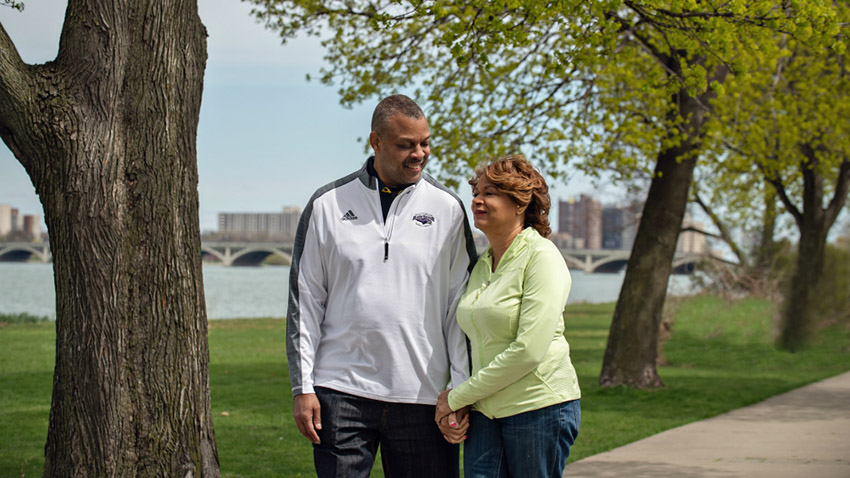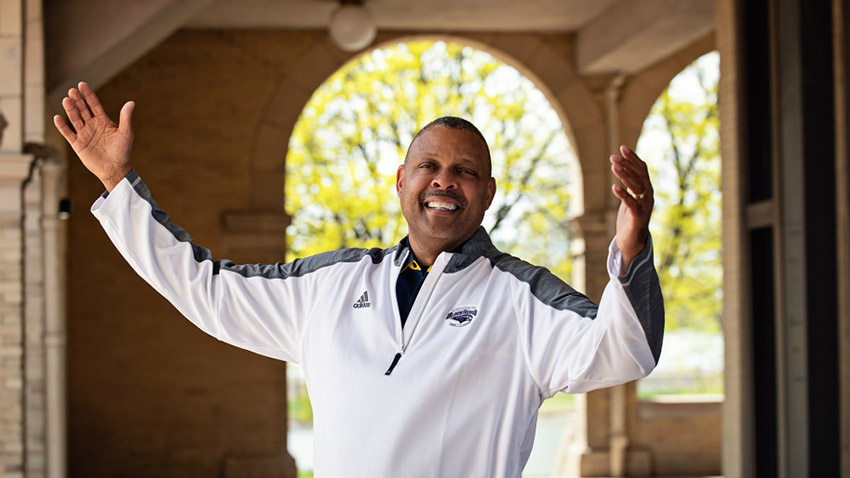Getting Through Stage 3 Sarcoma
How prayer and trust in his care team helped Gerald Dixon get through chemotherapy, radiation and surgery for stage 3 cancer

Photo Credit: Leisa Thompson
They called it The Beast. And Gerald Dixon credits his skilled care team, his family and his faith for vanquishing it -- the tumor that developed under his left arm.
“The important thing to know is that I didn’t go through this alone,” says Dixon, 61, a real estate entrepreneur and former automotive engineer from Southfield, Michigan. “I had my wife, family and spiritual friends with me throughout my entire experience.”
Nearly two years after being treated at the University of Michigan Rogel Cancer Center, Dixon has an active life that includes selling houses, jogging and plying the local rivers and lakes in his 27-foot cabin cruiser.
“I almost feel like I’m 18 all over again,” he says. “When you face a challenge like this, it gives you a new perspective.”
Dixon still keeps photos of The Beast on his smartphone, and also operating-room shots of the surgical wound where the softball-size growth had bedeviled him. They’re a graphic reminder of a difficult time, but also one whose poignancy it’s obvious Dixon doesn’t want to let blur or recede.
“I always say my diagnosis was sarcoma,” he says. “I never say I had sarcoma. That’s just my perspective, but I don’t claim it that way.”
Ma href="/sarcoma">Sarcoma is a rare type of cancer that develops in the body’s connective tissues — including muscles, fat and blood vessels. About 12,750 soft tissue sarcomas are diagnosed in the U.S. each year, according to the American Cancer Society, and more than 5,000 people die annually from the disease. Sarcoma can also develop in the bones.
Being Diagnosed with Stage 3 Cancer
In summer 2016, Dixon went to a hospital to have a golf ball-sized lump under his arm checked out. He thought maybe it was a boil. They sent him home, but he was soon back again. The lump was irritated and growing. The hospital scheduled an operation to remove it, but then hit pause until they could make a diagnosis. A subsequent biopsy revealed the lump was cancerous -- stage 3.
The family turned to Google and to prayer, and decided that the multidisciplinary sarcoma clinic at U-M’s Rogel Cancer Center was the best place for Dixon to pursue treatment.
It was at that first appointment that Dixon and his wife, Cheryl, met with oncologist Scott Schuetze, M.D., Ph.D., and other specialists.
Dixon was impressed that his medical team had already reviewed his records and were ready to recommend a treatment plan — one that included chemotherapy, radiation and surgery.
Unlike other types of cancer, sarcomas are often visible on the outside of the body, which can be a source of distress for patients, Schuetze explains. Many patients are eager to have their tumors surgically removed as soon as possible.
“And while we can do that, that’s probably not going to give you the best chances in the long run,” Schuetze says. “Even though a tumor is large and affecting, say, the ability to use an arm, or affecting the ability to sleep comfortably and causing pain, it’s better to pursue a logical treatment sequence that’s going to give patients the best chance for a cure.”
That sequence usually includes chemotherapy to prevent the cancer spreading to other parts of the body, and also radiation to keep the tumor from growing back again in the same spot, he says.
Sometimes patients are understandably anxious, Schuetze adds, especially if they can see their tumors and watch as they grow and change.
“Part of my role is just to reassure them we’ve seen this before and to help them understand they’re in good hands, with an experienced team on their side that knows how to manage this disease,” he says.
It was this calming presence that led Dixon to craft a nickname for his oncologist.
“I call Dr. Schuetze the Yoda of Sarcoma,” he says. “He’s that knowledgeable. There’s something very reassuring and calming when you’re going through a challenge and the people you’re talking with know how to talk to you about it, and have a deep knowledge about it.”
Other members of the care team included radiation oncologist Dawn Owens, M.D., Ph.D.; orthopedic surgeon Geoffrey Siegel, M.D.; and plastic surgeon Theodore Kung, M.D.
Sarcoma Cancer Treatment
Successive rounds of chemotherapy treatment were hard on Dixon. They made him tired and weak. Afterward, he sometimes didn’t have the energy for anything.
By comparison, the radiation treatment that came after the chemo was a breeze. The goal of radiation is to kill the cancer cells and prevent the tumor from regrowing after surgery.
Dixon’s engineering background helped him to appreciate the precision and complexity involved in the process, especially crafting the cast to immobilize his body and ensure the radiation targets precisely the same area during every treatment.
“So they lay me down and they’re like, ‘OK, 137 centimeters to the right, 36 centimeters north.’ It really stood out in my mind,” he says. “And when they finished, I told them, I’ve been around highly trained engineers and technicians throughout my career and what you just did was pretty elaborate -- and it was pretty cool. And of course once you go through radiation, you understand how important it is that they do hit the same spot exactly.”
Then, after radiation, came the operation to remove The Beast and a long, slow healing process.
While he was still wearing a brace to keep his arm immobilized, Dixon’s family brought him out to see their boat.
“They thought that would encourage me -- and it did,” he says. “All I kept thinking was, I have to get on that rascal this summer. There’s nothing more beautiful than a Michigan summer on the lake, that’s all I can tell you.”
Eventually, with encouragement and physical therapy, he was able to return to the captain’s chair.
Family and Faith Provide Support

Photo Credit: Leisa Thompson
Meeting Dixon, it’s obvious he’s one of those people for whom the phrase “he’s never met a stranger” was designed. In this, he says, he takes after his mother, Rita.
“I took her and my dad to Paris with me,” Dixon says. “She was talking to people everywhere we went. When I went back about a year later without her, the guy at the crêpe station said, ‘Where’s the chapeau lady?’ I said you’re kidding me -- because she wore these shiny hats.”
Dixon’s family was instrumental in supporting him through his treatment, including his three daughters, Shayla, Alexa and Asha, and son, Gerald. But his wife, Cheryl, was his bedrock.
“She was my travelling partner throughout the entire process -- every appointment I had, she was there,” he says. “We both work in our business together and we’re self-employed. So for both us of to be out of the office, that’s a pretty big deal. And it really helped me to understand what kind of spouse I had. I mean, I always knew I had a good one, but it’s a whole different thing when you’ve traveled a road together like that.”
Dixon also credits his Christian faith and the power of prayer with providing succor throughout his journey as a patient.
“I think I had some of the best doctors in the country working on my situation, but I also prayed for that, too,” he says. “And I prayed for them throughout the whole process. I appreciate them for honoring that and allowing me to do that with them.”
It’s clear faith is very important to some patients and their families, Schuetze says.
“Optimism is very important when patients have a serious cancer and are facing long treatment. It can help give them the strength to endure everything they need to go through, and if faith is a vital part of that, then I’m very supportive,” he says.
Asked what advice he would give to others traveling a similar road, Dixon responds from the perspective both of faith and practical wisdom:
“I prayed with my family before I started the process and there was just so much strength there,” he says. “But I’ll share with anyone regardless of where they’re at, you have to keep your attitude right, keep your confidence, trust God, and -- as much as you can -- don’t be afraid. Because that fear doesn’t bring anything positive to go forward. There almost is always some good in anything that’s a challenge. You just have to keep your eyes open so you can recognize it.”
Today Dixon is finished with his cancer treatments, sarcoma-free and continuing physical therapy with Mikhail Muhammad, D.P.T., which has helped him approach full use and range-of-motion in his arm.
